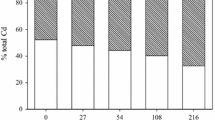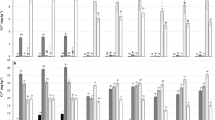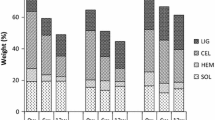Abstract
Purpose
We used a sequential extraction to investigate the effects of compost amendment on Cd fractionation in soil during different incubation periods in order to assess Cd stabilization in soil over time.
Methods
Pot experiments using rice plants growing on Cd-spiked soils were carried out to evaluate the influence of compost amendment on plant growth and Cd accumulation by rice. Two agricultural soils (Pinchen and Lukang) of Taiwan were used for the experiments. The relationship between the redistribution of Cd fractions and the reduction of plant Cd concentration due to compost amendment was then investigated.
Results and discussion
Compost amendment in Pinchen soil (lower pH) could transform exchangeable Cd into the Fe- and Mn-oxide-bound forms. With increasing incubation time, exchangeable Cd tended to transform into carbonate- and Fe- and Mn-oxide-bound fractions. In Lukang soil (higher pH), carbonate- and Fe- and Mn-oxide-bonded Cd were the main fractions. Exchangeable Cd was low. Compost amendment transformed the carbonate-bound form into the Fe and Mn oxide form. Pot experiments of rice plants showed that compost amendment enhanced plant growth more in Pinchen soil than in Lukang soil. Compost amendment could significantly reduce Cd accumulation in rice roots in both Pinchen and Lukang soils and restrict internal transport of Cd from the roots to the shoots. Because exchangeable Cd can be transformed into the stronger bonded fractions quickly in Pinchen soil, a reduction of Cd accumulation in rice due to compost amendment of Pinchen soil was significant by 45 days of growth. However, carbonate-bonded fractions in Lukang soil may provide a source of available Cd to rice plants, and exchangeable and carbonate-bonded fractions are transformed into the other fractions slowly. Thus, reduction of Cd accumulation by rice due to compost amendment in Lukang soil was significant by 75 days of growth.
Conclusions
The results of the study suggest that the effectiveness of compost amendment used for stabilization of Cd and to decrease the phytoavailability of Cd for rice plants is different in acidic and alkaline soils. In acidic soil, Cd fractionation redistributes quickly after compost amendment and shows a significant reduction of Cd accumulation by the plant within a few weeks. In alkaline soil, due to the strongly bound fractions of Cd being in greater quantity than the weakly bound ones, a longer period (a few months) to redistribute Cd fractions is needed.


Similar content being viewed by others
References
Adriano DC (2001) Cadmium. In: Adriano DC (ed) Trace element in terrestrial environments: biogeochemistry, bioavailability, and risks of metals. Springer, New York, pp 264–314
Ahnstrom ZS, Parker DR (1999) Development and assessment of a sequential extraction procedure for the fractionation of soil cadmium. Soil Sci Soc Am J 63:1650–1658
Almås A, Singh BR, Salbu B (1999) Mobility of cadmium-109 and zinc-65 in soil influenced by equilibration time, temperature, and organic matter. J Environ Qual 28:1742–1750
Baker AJM (1981) Accumulations and excluders—strategies in the response of plants to heavy metals. J Plant Nutr 3:643–654
Basta NT, McGowen SL (2004) Evaluation of chemical immobilization treatments for reducing heavy metal transport in a smelter-contaminated soil. Environ Pollut 127:73–82
Bataillard P, Cambier P, Picot C (2003) Short-term transformation of lead and cadmium compounds in soil after contamination. Eur J Soil Sci 54:365–376
Bergkvist P, Jarvis NJ, Berggren D, Carlgren K (2003) Long-term effects of sewage sludge applications on soil properties, cadmium availability and distribution in arable soil. Agric Ecosyst Environ 97:167–179
Bergkvist P, Berggren D, Jarvis NJ (2005) Cadmium solubility and sorption in a long-term sludge-amended arable soil. J Environ Qual 34:1530–1538
Bernal MP, Navarro AF, Sanchez-Monedero MA, Roig A, Cegarra J (1998) Influence of sewage sludge compost stability and maturity on carbon and nitrogen mineralization in soil. Soil Biol Biochem 30:305–313
Bose S, Bhattacharyya AK (2008) Heavy metal accumulation in wheat plant grown in soil amended with industrial sludge. Chemosphere 70:1264–1272
Brown S, Chaney R, Hallfrisch J, Ryan JA, Berti WR (2004) In situ treatments to reduce the phyto- and bio-availability of lead, zinc, and cadmium. J Environ Qual 33:522–531
Carapeto C, Purchase D (2000) Use of sequential extraction procedures for the analysis of cadmium and lead in sediment samples from a constructed wetland. Environ Contam Toxicol 64:51–58
Chen M, Ma LQ (2001) Comparison of three aqua regia digestion for twenty Florida soils. Soil Sci Soc Am J 65:491–499
Clemente R, Walker DJ, Roig A, Bernal MP (2003) Heavy metal bioavailability in a soil affected by mineral sulphides contamination following the mine spillage at Aznalcóllar (Spain). Biodegradation 14:199–205
Clemente R, Escolar Á, Bernal MP (2006) Heavy metals fractionation and organic matter mineralization in contaminated calcareous soil amended with organic materials. Bioresou Technol 97:1894–1901
Collins RN, Merrington G, McLaughlin MJ, Morel J-L (2003) Organic ligand and pH effects on isotopically exchangeable cadmium in polluted soils. Soil Sci Soc Am J 67:112–121
Das P, Samantaray S, Rout GR (1997) Studies on cadmium toxicity in plants: a review. Environ Pollut 98:29–36
Davies NA, Hodson ME, Black S (2003) The influence of time on lead toxicity and bioaccumulation determined by the OECD earthworm toxicity test. Environ Pollut 121:55–61
Domínguez MT, Madrid F, Marañón T, Murillo JM (2009) Cadmium availability in soil and retention in oak roots: potential for phytostabilization. Chemosphere 76:480–486
Epstein E (1997) Trace elements, heavy metals and micronutrients. In: Epstein E (ed) The science of composting. Technomic, Lancaster, pp 137–170
Fendorf S, Force MJL, Li G (2004) Temporal changes in soil partitioning and bioaccessibility of arsenic, chromium, and lead. J Environ Qual 33:2049–2055
Gao Y, He J, Ling W, Hu H, Liu F (2003) Effects of organic acids on copper and cadmium desorption from contaminated soils. Environ Int 29:613–618
Gee GW, Bauder JW (1986) Particle-size analysis. In: Klute A (ed) Methods of soil analysis, part, physical and mineralogical methods. ASA and SSSA, Madison, pp 383–411
Han FX, Banin A, Triplett GB (2001) Redistribution of heavy metals in arid-zone soils under a wetting–drying cycle soil moisture regime. Soil Sci 166:18–28
Hattori H, Kuniyasu K, Chiba K, Chino M (2006) Effect of chloride application and low soil pH on cadmium uptake from soil by plants. Soil Sci Plant Nutr 52:89–94
Hettiarachchi GM, Scheckel KG, Ryan JA, Sutton SR, Newville M (2006) μ-XANES and μ-XRF investigations of metal binding mechanisms in biosolids. J Environ Qual 35:342–351
Hong CO, Lee DK, Kim PJ (2008) Feasibility of phosphate fertilizer to immobilize cadmium in a field. Chemosphere 70:2009–2015
Jalali M, Khanlari ZV (2008) Effect of aging process on the fractionation of heavy metals in some calcareous soils of Iran. Geoderma 143:26–40
Kabala C, Singh BR (2001) Fractionation and mobility of copper, lead, and zinc in soil profiles in the vicinity of a copper smelter. J Environ Qual 30:485–492
Kim IS, Kang KH, Jhnson-Green P, Lee EJ (2003) Investigation of heavy metal accumulation in Polygonum thunbergii for phytoextraction. Environ Pollut 126:235–243
Lee S-H, Lee J-S, Choi YJ, Kim J-G (2009) In situ stabilization of cadmium-, lead-, and zinc-contaminated soil using various amendments. Chemosphere 77:1069–1075
Lim TT, Tay JH, Teh CI (2002) Contamination time effect on lead and cadmium fractionation in a tropical coastal clay. J Environ Qual 31:806–812
Liu WJ, Zhu YG, Hu Y, Williams PN, Gault AG, Meharg AA, Charnock JM, Smith FA (2006) Arsenic sequestration in iron plaque, its accumulation and speciation in mature rice plants (Oryza sativa L.). Environ Sci Technol 40:5730–5736
Liu J, Qian M, Cai G, Yang J, Zhu Q (2007a) Uptake and translocation of Cd in different rice cultivars and the relation with Cd accumulation in rice grain. J Hazard Mater 143:443–447
Liu HJ, Zhang JL, Zhang FS (2007b) Role of iron plaque in Cd uptake by and translocation within rice (Oryza sativa L.) seedlings grown in solution culture. Environ Exp Bot 59:314–320
Liu HJ, Zhang JL, Christie P, Zhang FS (2008) Influence of iron plaque on uptake and accumulation of Cd by rice (Oryza sativa L.) seedlings grown in soil. Sci Total Environ 394:361–368
Lu A, Zhang S, Shan X (2005) Time effect on the fractionation of heavy metals. Geoderma 125:225–234
Luo YM, Christie P (1998) Bioavailability of copper and zinc in soils treated with alkaline stabilized sewage sludges. J Environ Qual 27:335–342
Martínez CE, Jacobson AR, McBride MB (2003) Aging and temperature effects on DOC and elemental release from a metal contaminated soil. Environ Pollut 122:135–143
McLean EO (1982) Soil pH and lime requirement. In: Page AL, Miller RH, Keeney DR (eds) Methods of soil analysis, part 2, chemical and microbiological properties. ASA and SSSA, Madison, pp 199–223
Narwal RP, Singh BR, Salbu B (1999) Association of cadmium, zinc, copper, and nickel with components in naturally heavy metal-rich soils studied by parallel and sequential extractions. Commun Soil Sci Plant Anal 30:1209–1230
Nelson DW, Sommers LE (1996) Total carbon, organic carbon, and organic matter. In: Sparks DL (ed) Methods of soil analysis, part 3, chemical methods. ASA and SSSA, Madison, pp 961–1010
Ok Y-S, Lee H, Jung J, Song H, Chung N, Lim S, Kim J-G (2004) Chemical characterization and bioavailability of cadmium in artificially and naturally contaminated soils. Agric Chem Biotechnol 47:143–146
Pueyo M, Sastre J, Hernandez E, Vidal M, López-Sánchez JF, Rauret G (2003) Prediction of trace element mobility in contaminated soils by sequential extraction. J Environ Qual 32:2054–2066
Rajaie M, Karimian N, Maftoun M, Yasrebi J, Assad MT (2006) Chemical forms of cadmium in two calcareous soil textural classes as affected by application of cadmium-enriched compost and incubation time. Geoderma 136:533–541
Römkens PFAM, Guo HY, Chu CL, Liu TS, Chiang CF, Koopmans GF (2009) Prediction of cadmium uptake by brown rice and derivation of soil-plant transfer models to improve soil protection guidelines. Environ Pollut 157:2435–2444
Shuman LM (1991) Chemical forms of micronutrients in soils. In: Mortvedt JJ, Cox FR, Shuman LM, Welch RM (eds) Micronutrients in agriculture, vol 4, SSSA Book. SSSA, Madison, pp 113–144
Shuman LM (1999a) Effect of organic waste amendments on zinc adsorption by two soils. Soil Sci 164:197–205
Shuman LM (1999b) Organic waste amendments effect on zinc fractions of two soils. J Environ Qual 28:1442–1447
Singh RP, Agrawal M (2010) Variations in heavy metal accumulation, growth and yield of rice plants grown at different sewage sludge amendment rates. Ecotox Environ Safe 73:632–641
Singh BR, McLaughlin MJ (1999) Cadmium in soils and plants. In: Mclaughlin MJ, Singh BR (eds) Cadmium in soils and plants. Kluwer, Dordrecht, pp 257–267
Stietiya MH, Wang JJ (2011) Effect of organic matter oxidation on the fractionation of copper, zinc, lead, and arsenic in sewage sludge and amended soils. J Environ Qual 40:1162–1171
Tang X-Y, Zhu Y-G, Cui Y-S, Duan J, Tang L (2006) The effect of aging on the bioaccessibility and fractionation of cadmium in some typical soils of China. Environ Int 32:682–689
Tejada M, Hernandez MT, Garcia C (2006) Application of two organic amendments on soil restoration: effects on the biological properties. J Environ Qual 35:1010–1017
Tessier A, Campbell PGC, Bisson M (1979) Sequential extraction procedure for the speciation of particulate trace metals. Anal Chem 51:844–851
Thomas GW (1982) Exchangeable cations. In: Page AL, Miller RH, Keeney DR (eds) Methods of soil analysis, part 2, chemical and microbiological properties. ASA and SSSA, Madison, pp 159–165
Tordoff GM, Baker AJM, Willis AJ (2000) Current approaches to the revegetation and reclamation of metalliferous mine wastes. Chemosphere 41:219–228
Udovic M, Lestan D (2009) Pb, Zn and Cd mobility, availability and fractionation in aged soil remediated by EDTA leaching. Chemosphere 74:1367–1373
Vaca-Paulín R, Esteller-Alberich MV, Lugo-de la Fuente J, Zavaleta-Mancera HA (2006) Effect of sewage sludge or compost on the sorption and distribution of copper and cadmium in soil. Waste Manag 26:71–81
Walker DJ, Clemente R, Roig A, Bernal MP (2003) The effects of soil amendments on heavy metal bioavailability in two contaminated Mediterranean soils. Environ Pollut 122:303–312
Walker DJ, Clemente R, Bernal MP (2004) Contrasting effects of manure and compost on soil pH, heavy metal availability and growth of Chenopodium album L. in a soil contaminated by pyritic mine waste. Chemosphere 57:215–224
Walter I, Cuevas G (1999) Chemical fractionation of heavy metals in a soil amended with repeated sewage sludge application. Sci Total Environ 226:113–119
Wang Z, Shan X, Zhang S (2002) Comparison between fractionation and bioavailability of trace elements in rhizosphere and bulk soils. Chemosphere 46:1163–1171
Wang X-P, Shan X-Q, Zhang S-Z, Wen B (2004) A model for evaluation of the phytoavailability of trace elements to vegetables under the field conditions. Chemosphere 55:811–822
Wang GD, Koopmans GF, Song J, Temminghoff EJM, Luo YM, Zhao QG, Japenga J (2007) Mobilization of heavy metals from contaminated paddy soil by EDDS, EDTA, and elemental sulfur. Environ Geochem Hlth 29:221–235
Wong JWC, Selvam A (2006) Speciation of heavy metals during co-composting of sewage sludge with lime. Chemosphere 63:980–986
Zheljazkov VD, Warman PR (2004) Phytoavailability and fractionation of copper, manganese, and zinc in soil following application of two composts to four crops. Environ Pollut 131:187–195
Zhou LX, Wong JWC (2001) Effect of dissolved organic matter from sludge and sludge compost on soil copper sorption. J Environ Qual 30:878–883
Acknowledgments
This research was sponsored by the Agriculture and Food Agency, Council of Agriculture, Taiwan, under grant no. 94AS-8.1.3-FD-Z1(2) and by the National Science Council, Taiwan under grant no. NSC 97-2313-B-451-009-MY3.
Author information
Authors and Affiliations
Corresponding author
Additional information
Responsible editor: Zhihong Xu
Rights and permissions
About this article
Cite this article
Juang, KW., Ho, PC. & Yu, CH. Short-term effects of compost amendment on the fractionation of cadmium in soil and cadmium accumulation in rice plants. Environ Sci Pollut Res 19, 1696–1708 (2012). https://doi.org/10.1007/s11356-011-0684-0
Received:
Accepted:
Published:
Issue Date:
DOI: https://doi.org/10.1007/s11356-011-0684-0




